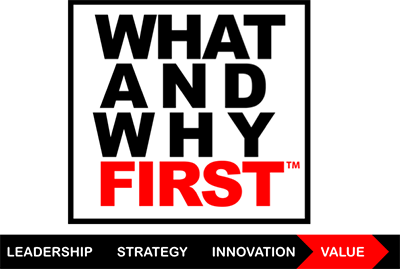Make Strategic Planning Better with Clarity of Intention

Our topic today is strategic planning. If I ask you for examples of strategy, most likely your examples will fall into the following three categories:
1. Operational activities, like “launch a new product.”
2. Business objectives, such as “reduce the costs of sales by 15%.”
3. Broad generic descriptions of what is happening, like “engaging the customer” or “planning end-to-end product functions.”
I hate to break it to you, but none of those examples are strategy.
Many executives talk “strategy,” but they’re often confused about what it means. The confusion is about understanding the differences between business objectives (the what), strategy (the why), and operational activities (the where, the when, the who, and the how).

So, let’s discuss the variables and level set.
Business objectives are defined at the organizational level. On the opposite side of that, operational activities fall under the supervision of operational managers. They might think strategy is to focus on what they do day after day, but that is not strategy either.
Strategy is the “why” between the business objectives and the operational activities. When it comes to viable strategic planning, think of the reasons businesses and organizations exist.
First, businesses are part of a larger ecosystem in conjunction with other important stakeholders such as customers, employees, suppliers, vendors, shareholders, and other partners. All these stakeholders are connected. Some of the connections are transactional, like when a customer buys a product or service. Some other connectors are more relational, like the ones that exist between employees and customers.
With that in mind, the main purpose of strategic planning is to leverage your business ecosystem. In other words, strategic planning brings clarity of intention amidst all the moving pieces within that business ecosystem.
That clarity ensures that the business objectives are crystal clear. As a result, operational activities are better aligned to execute the transactions that enhance the relationships and experiences among stakeholders. With clarity of intention, your organization creates and delivers the agreed intended value, while still achieving the objectives of the organization.

I want you to strive for that clarity of intention at your next strategic planning sessions.
Here are three steps I recommend to bring clarity of intention to the forefront:
1. Make your strategic planning truly strategy driven. There is no place for ambiguity or fogginess. Gain a deep understanding of the difference between your business objectives, your strategy, and your day-to-day operational activities.
2. Know your business ecosystem. You cannot create a viable strategic plan in the dark. Use business architecture not only to understand your ecosystem but to also optimize your strategy for execution performance.
3. Communicate the “why.” Spend as much time as needed communicating the reasoning behind the strategic plan. Remember, people don’t follow what you do; they follow “why” you do it.
Now, it is your turn. I would like to hear from you. What approach do you use for strategic planning? In your experience, what makes or breaks a strategic plan?
Your comments and feedback are gold!
Please, leave a comment, share this video, connect or follow me on LinkedIn, and check out my website: whatandwhyfirst.com.
Until next time, cheers!
